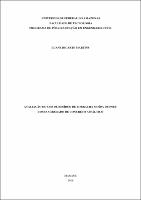| ???jsp.display-item.social.title??? |


|
Please use this identifier to cite or link to this item:
https://tede.ufam.edu.br/handle/tede/8014| ???metadata.dc.type???: | Dissertação |
| Title: | Avaliação do uso de resíduo de borracha moída de pneu como agregado de concreto asfáltico |
| ???metadata.dc.creator???: | Martins, Luane Ricarte  |
| ???metadata.dc.contributor.advisor1???: | Campelo, Nilton de Souza |
| ???metadata.dc.contributor.referee1???: | Rocha, Francisco dos Santos |
| ???metadata.dc.contributor.referee2???: | Santana, Genilson Pereira |
| ???metadata.dc.description.resumo???: | Este trabalho tem objetivo de estudar o potencial da utilização de borracha de pneu triturada em substituição parcial dos agregados em misturas asfálticas por meio do processo seco, obtendo-se um material com propriedades que permitam seu uso na pavimentação. Para que seja possível atingir estes objetivos, primeiramente foram realizados os ensaios de caracterização dos materiais utilizados e das misturas para que se pudesse conhecer o objeto de estudo. Também foi analisada a influência do efeito da adição de raspas de borracha de pneu sob os vários aspectos que condicionam o bom desempenho de uma mistura em campo através da caracterização mecânica. As conclusões deste trabalho indicam que a amostra escolhida para estudos de 5,58% de CAP e 0,5% de borracha, no geral, obteve resultados positivos quando comparados aos resultados da amostra de referência, com exceção no ensaio de perda de massa, onde a amostra modificada apresentou um desgaste levemente maior, porém menor que 1%. As conclusões também indicaram que a incorporação de borracha de pneus inservíveis em concreto asfáltico pode ser uma alternativa viável para a reciclagem desses resíduos, porém ainda há bastante informação para ser estudada e analisada. |
| Abstract: | The aim of this work is to study the potential of the use of crushed tire rubber in partial replacement of the aggregates in asphalt mixtures by means of the dry process, obtaining a material with properties that allow its use in the paving. In order to achieve these objectives, the characterization tests of the materials used and the mixtures will be carried out first so that the object of study can be known. The influence of tire rubber particle percentages on the mixtures and the effect of the addition of tire rubber shavings under the various aspects that condition the good performance of a field mix through mechanical characterization. The conclusions of this work indicate that the sample chosen for studies of 5.58% of petroleum asphalt concrete and 0.5% of rubber, in general, obtained positive results when compared to the results of the reference sample, except for the mass loss test. where the modified sample had a slightly higher wear, but less than 1%. The findings also indicated that incorporating rubber from waste tires into asphalt concrete may be a viable alternative for recycling these wastes, but there is still plenty of information to be studied and analyzed. |
| Keywords: | Pavimentos Pavimentos de asfalto |
| ???metadata.dc.subject.cnpq???: | ENGENHARIAS |
| ???metadata.dc.subject.user???: | Avaliação Asfalto Borracha Pavimentação |
| Language: | por |
| ???metadata.dc.publisher.country???: | Brasil |
| Publisher: | Universidade Federal do Amazonas |
| ???metadata.dc.publisher.initials???: | UFAM |
| ???metadata.dc.publisher.department???: | Faculdade de Tecnologia |
| ???metadata.dc.publisher.program???: | Programa de Pós-graduação em Engenharia Civil |
| Citation: | MARTINS, Luane Ricarte. Avaliação do uso de resíduo de borracha moída de pneu como agregado de concreto asfáltico. 2019. 59 f. Dissertação (Mestrado em Engenharia Civil) - Universidade Federal do Amazonas, Manaus (AM), 2019. |
| ???metadata.dc.rights???: | Acesso Aberto |
| URI: | https://tede.ufam.edu.br/handle/tede/8014 |
| Issue Date: | 12-Dec-2019 |
| Appears in Collections: | Mestrado em Engenharia Civil |
Files in This Item:
| File | Description | Size | Format | |
|---|---|---|---|---|
| Dissertação_LuaneMartins_PPGEC..pdf | 1.89 MB | Adobe PDF |  Download/Open Preview |
Items in DSpace are protected by copyright, with all rights reserved, unless otherwise indicated.




